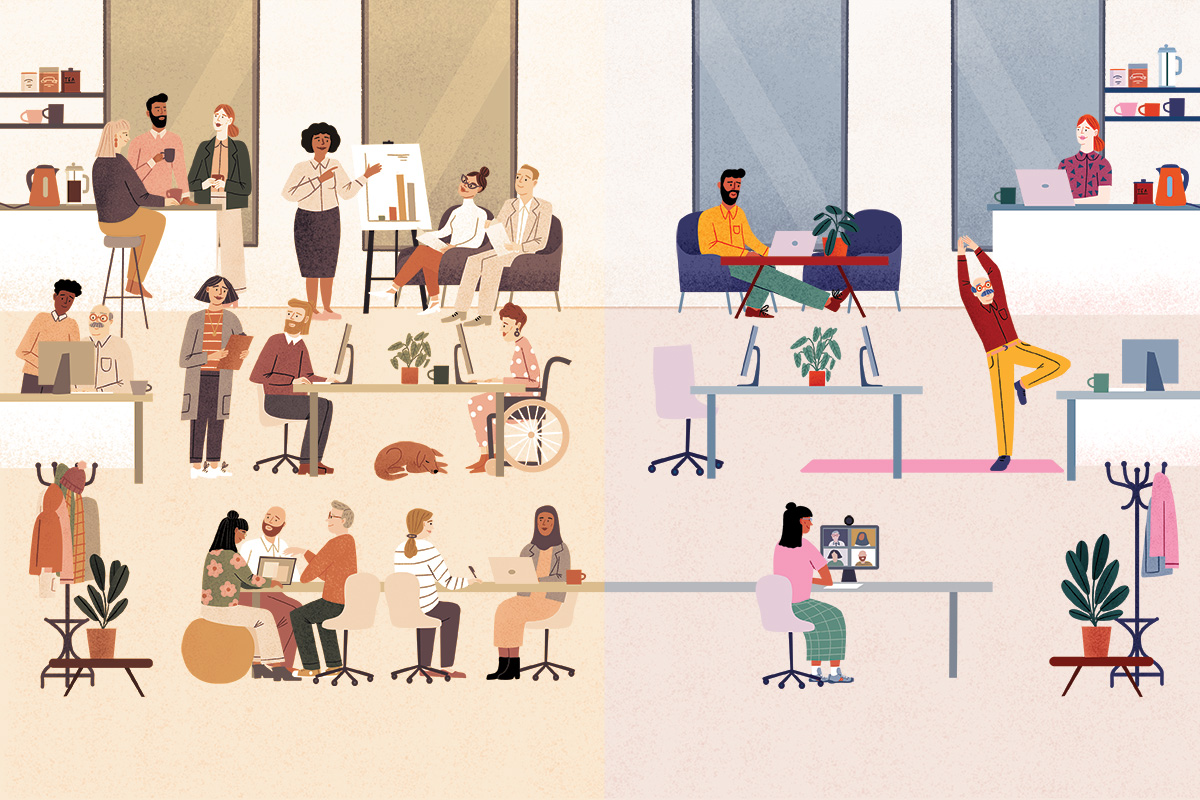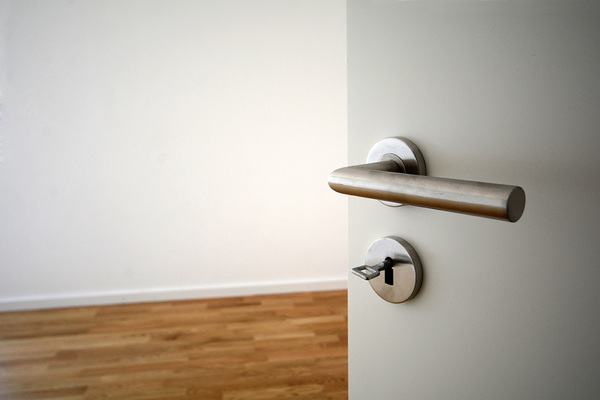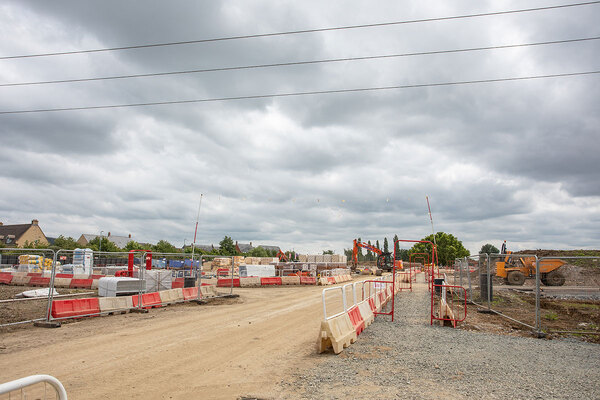Is it the end of the office?
Will 2021 spell the end of the traditional office for social landlords? Our survey finds out who is looking at changing how they work following COVID-19 and how they have coped so far. Chaminda Jayanetti reports. Illustration by Bett Norris
The pandemic has had a number of knock-on effects upon the way we all live our lives, not least the rise in home-working. Inside Housing sent a survey to housing associations to find out whether COVID-19 has changed the way their staff work.
The survey drew 43 responses from housing associations employing 35,000 staff, encompassing big organisations and small ones, located across the country. Almost all were primarily office-based before the pandemic in terms of administrative and head office staff. While many offered some level of flexible working, the actual take-up of this tended to be occasional and ad hoc – even an association that described itself as having a “flexible, agile culture” had only 20-25% of staff working a day a week from home pre-COVID-19.
Nevertheless, some associations had been preparing to shift to more flexible forms of working.
“I think we always had in the roadmap that in a couple of years’ time we would have home-working as a capability anyway. The pandemic brought everything forward 18 months”
“We were already starting to work in a very agile way prior to COVID hitting everybody,” says Nina Evison, head of people at Yorkshire Housing. “So for a number of our customer-facing roles we’d moved away from people being based in a traditional office into a more agile way of working. But for a number of our colleagues who were based in our head office in Leeds, most of the time most of those people were still working in quite a traditional way, and we were just taking steps towards what an agile, more flexible future might look like.”
“I think we always had in the roadmap that in a couple of years’ time we would have home-working as a capability anyway. The pandemic brought everything forward 18 months,” says Stephen Joyce, human resources director at Your Housing Group.
Every single association that responded to our survey has switched its office staff to home-working, with small numbers sometimes continuing in the office if, for practical or well-being reasons, working from home is not an option.
Associations that had already begun shifting towards flexible working models found this helped the shift to wholesale home-working in March.
“We found that we were able to very quickly enable people to work from home when the first lockdown started,” says Ms Evison. “For example, most people already had really good IT kit because our digital strategy was well under way, but we were able to accelerate that.”
Yorkshire Housing provided home-workers with laptops, smartphones and other devices, fully funded by the company. And Abri, like many associations, provided monitors, keyboards, desks and chairs as necessary.
Associations that had been planning to shift to more ‘agile’ working saw this supply of company-funded equipment to home-workers as part of establishing this change for the long term, as well as helping staff during the pandemic.
“We made that investment in our colleagues for future agility knowing that while we were working in a pandemic and working predominantly at home, accelerating our move towards a more agile type of approach to work was on the cards,” says Sarah Allen, director of optimisation and business improvement at Abri.
But while administrative staff can readily work from home, others cannot. Care workers in supported housing, emergency repairs workers and other operative staff continue to work on site, necessitating safety measures such as risk assessments and PPE.
“The overwhelming feedback is that colleagues who were based in an office have told us they don’t want to return to working nine-to-five in an office, it’s as simple as that”
John Gray, a national executive committee member with trade union Unison, says that while most associations stepped up to the plate in keeping staff safe and supported during the pandemic, “a small minority have acted very, very badly”.
“I think [there’s] a cultural problem in some organisations with health and safety,” he adds. “It wasn’t taken seriously before COVID. Our members had to go into people’s homes to fix leaks, gas safety, and especially if you had a family member with a medical condition who is shielding, it was a very, very difficult time. They didn’t want to be responsible for the death of their loved one.”
Almost universally, associations say they have consulted with home-working staff or sought feedback from them on their new working arrangements.
This has led to some changes in response to concerns about social isolation while working from home.
“There’s been some other informal things we’ve done to keep that community and not have people feeling isolated,” says Greg Bowkett, head of human resources at Housing 21. “So, for example, putting in place ‘virtual kitchen’ sessions where people can kind of drop in over their lunchtime so that they’re still able to talk to people like they would if they were in the shared office kitchen.”
Many associations have introduced online social activities to reduce isolation, plus occasional special events. Housing 21 put on a ‘virtual summer festival’, while another hosted ‘digital raves’.
But organisations say there is broad support for home-working among staff.
“The overwhelming feedback is that colleagues who were based in an office have told us they don’t want to return to working nine-to-five in an office, it’s as simple as that,” says Ms Evison.
“There’s a strong desire to move away from regular commuting, and there’s that sort of sense of the presenteeism culture that’s created by a traditional office. People have got much more freedom to work in a way that suits them, and work hours that suit them around the needs of customers.”
Almost all associations are planning to move towards ‘blended’ working after the pandemic, with no mass return to the office. Instead, staff will combine working from home with spending varying degrees of time in the office to see colleagues, hold meetings or collaborate.
“Working at home all day, every day, is not agile working – that’s home-working,” says Abri’s Ms Allen. “A flexible way of working could be anything from being in the office one or two days, but also being out and about in the community, having a meeting maybe at a third-party workspace, working from a collaborative area or a touchdown space, and then being at home a day or two a week.”
In numbers
18.6%
Providers that have permanently closed some office spaces or expect to (26% unsure)
76.7%
Providers that expect changes to work practices, such as work-from-home measures, to be permanent
16.2%
Providers that currently have staff furloughed
Source: Inside Housing survey, conducted during October/November 2020. There were 43 respondents.
This shift also means associations are less likely to need all their current office space.
Around half of housing associations say they will keep all their current offices open, while 17 are either planning to close some offices or are reviewing their estate, potentially repurposing offices as space for community organisations or as new housing, or simply selling them off.
“We’ll encourage people to go to the building, but not to sit at a desk and work. So it’s going to have a gym facility, it’ll have a coffee shop where people can mix, a collaboration floor, and then there’ll be a formal business lounge on the top floor”
Yorkshire Housing expects to move to a model of smaller, flexible workspaces combined with mostly agile working, although it has no firm plans yet.
“We want to try and move people away from feeling like there’s a need to come into a central space, if actually the work that people are doing can be much more local,” says Ms Evison.
Your Housing is ramping up pre-COVID-19 plans to downsize its estate, shutting three offices and replacing them with a new ‘collaboration centre’, partly in response to fears over home-workers’ isolation.
“We’ll encourage people to go to the building, but not to sit at a desk and work. So it’s going to have a gym facility, it’ll have a coffee shop where people can mix, a collaboration floor, and then there’ll be a formal business lounge on the top floor,” says Mr Joyce.
“Someone who works in central services – example, me – would probably expect to go to that building two or three times a week, maybe for three or four-hour bursts at a time. But it’ll be designed in a way where I can’t go and hide at a desk all day and sit there for eight hours, but I’ll be able to go and collaborate, I’ll be able to interact with people and remove that isolation worry.”
Unison’s Mr Gray accepts that there may be a case for long-term shifts to home-working and downsized office space, but he urges associations not to rush in.
“It is too early to be talking about closing offices down and everybody working from home,” he says. “It certainly has worked really, really well for some staff, but for other staff it hasn’t, and we’ve definitely seen an increase of people suffering from depression because going to work is important for a whole range of reasons, including people’s self-esteem, to enjoy the company of friends and colleagues.”
“A lot of organisations were providing people during lockdown with a little pack with a teabag and a KitKat in it to say thank you. And we wanted to do something that felt a little bit bigger”
He also warns against the closure of local housing offices. “There will be less physical contact with residents and housing officers. I will argue to the end of my days as somebody who’s worked on a housing estate, it’s really, really important to have a local presence.”
While businesses have been supportive in easing the transition to home-working, they have been more cautious on pay and conditions. Around half the respondents to the Inside Housing survey had made no increase to any staff pay during the pandemic, one organisation saying it had “held back from making pay increases so far in this financial year in order to maintain reserves in case of major issues arising”.
“Obviously the next stage is how we’re going to pay the cost of greater rent arrears, more expensive management because of COVID restrictions, and I hope and I expect employers not to expect their staff to suffer a detriment from this,” Mr Gray says.
Some associations have given staff pay rises or bonuses, boosted statutory sick pay or topped up furlough payments.
Yorkshire Housing introduced a perk in the form of a Health Cash Plan benefit, which allows staff to claim back money they have spent on everyday health treatments, including everything from dental and optical checks to massage, pedicures and reiki, to a maximum total value of more than £1,000.
“A lot of organisations were providing people during lockdown with a little pack with a teabag and a KitKat in it to say thank you. And we wanted to do something that felt a little bit bigger,” says Ms Evison.
Associations were already gradually moving towards flexible working, with more home-workers and in some cases less office space. COVID-19 has not changed everything so much as sped things up. But these changes are not just about dealing with the current crisis – they are also a form of future-proofing. “Who’s to say there wouldn’t be another pandemic?” Mr Joyce says.
We can at least hope there will not be another quite like this for some years yet. But even if the impact of COVID-19 fades, the upsurge in home-working appears to be going nowhere fast.
Sign up for our Week in Housing newsletter
Already have an account? Click here to manage your newsletters














